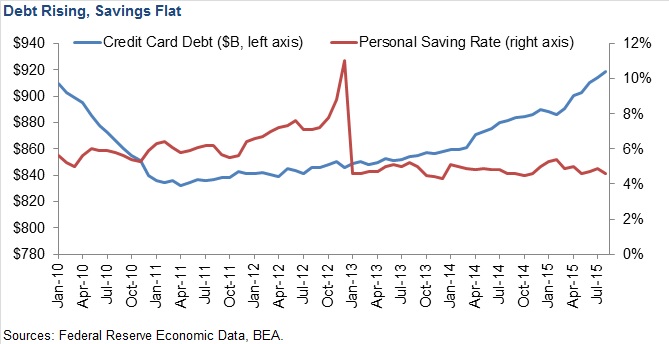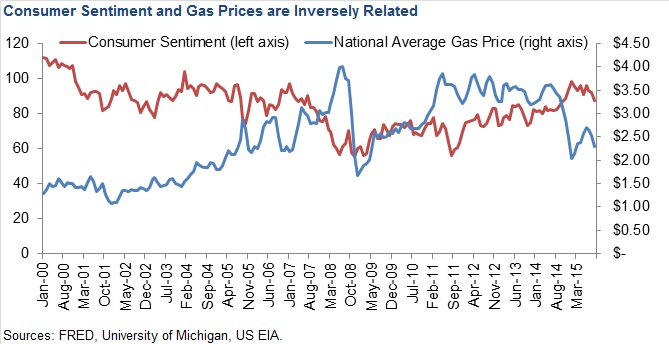The Real Benefit of Low Gas Prices
Forest is an intern from Monument Mountain High School in Great Barrington, Massachusetts. He plans to study business and engineering in college starting next fall.
Since September of 2014, the price of gasoline has fallen by more than a dollar per gallon as a result of the lower crude oil prices. For the average American consumer, this means their expenditures on gasoline have fallen by $22 per month. The total amount “saved” by Americans as a result of this decrease in gas prices is about $100 billion per quarter for the last several quarters. Where has this this money gone? We look at three data sources to try to identify what Americans are doing with this financial windfall:
- Are they saving more?
- Are they paying off debt at a faster pace?
- Are they spending more?
First, we look at the personal saving rate. It turns out that the saving rate has changed little during this period. It rose from 4.6 percent in September 2014, peaked at 5.3 percent in February 2015 and then fell back to 4.7 percent in June. Our analysis suggests that the link between gas prices and personal saving has been weak over the last 20 years, and the previous year has been no different. It does not seem on aggregate that people are using the money they didn’t spend on gas to increase savings.
Next, we look at total debt associated with credit cards (“revolving credit”) to see whether people are paying down these balances. As it turns out, revolving credit increased during the period in question. It rose from $883 billion in September of 2014 to $900 billion in April 2015 and $919 billion as of August. The total increase in revolving credit debt was nearly 4 percent, suggesting that Americans are not paying off bills. On the contrary, they’re actually spending more:
This really leaves only one option for what people are doing with this money. They’re spending it. According to a recent survey conducted by JP Morgan, “individuals are [in fact] spending roughly 80%” of money saved on gasoline.
Given this spending, we look at GDP figures to see whether it has had a sizeable impact on economic growth. GDP rose by 2.2 percent from Q3 2014 through Q2 2015, a total increase of about $390 billion. The economy is growing, but the rate of growth remains little changed from the previous year’s growth of 2.4 percent. If Americans are in fact spending more, then why are we seeing such slow growth in the economy? The problem is that $80 billion is a relative drop in the bucket for the $18 trillion American economy.
Despite these relatively small impacts on the broader economy, there is some good news. Even if people are not saving more or paying off debt, they are definitely feeling better and more optimistic about the economy. Gas prices have always had a high, negative correlation with consumer sentiment. This means that when gas prices fall, people tend to feel better about the economy – and vice versa.
Although there has been a recent hiccup, consumer sentiment has risen over the last year. Whether or not there is a massive economic impact, people are feeling good about their personal finances. Consumer sentiment peaked in January and remains higher than at any point since 2007. This optimism may turn out to be the best thing to come out of the decrease in gas prices.










